Begonia Boliviensis plant has captured the hearts of gardeners worldwide. Originating from the cool mountain slopes of Bolivia and Argentina, this vibrant plant has made its way into gardens across the globe thanks to its striking flowers and resilient nature.
Understanding Begonia Boliviensis: A Closer Look
The Begonia Boliviensis, also known as the Bolivian Begonia, is a fascinating plant with unique characteristics. Let’s delve deeper into what makes this plant so special:
Origin and Species
The Begonia Boliviensis is a part of the Begonia genus, which comprises around 1,500 species and 10,000 cultivars of herbaceous plants. This particular species is native to Bolivia and Argentina’s subtropical and tropical regions, hence its name.
Plant Structure:
This plant is a perennial herbaceous species, which means it lives for more than two years and has leaves and stems that die down at the end of the growing season. It has a hanging or trailing habit, making it perfect for hanging baskets or elevated planters.
Leaves
The leaves of the Begonia Boliviensis are a sight to behold. They are arrow-shaped, with a serrated edge, and can be either green or bronze, depending on the variety. These leaves provide a beautiful backdrop to the plant’s vibrant flowers.
Flowers
The true stars of the Begonia Boliviensis are its flowers. These showy, pendulous blooms can be red, white, or pink from late spring to early fall. Each flower has five petals that recurve as they open, creating an elegant effect.
Varieties
There are several varieties and hybrids of Begonia Boliviensis, each with a unique charm. For instance, the ‘Santa Cruz variety is known for its fiery red flowers, while the ‘Bonfire’ variety boasts striking orange blooms. The ‘Begonia Boliviensis Bonfire’ is particularly popular for its bronze foliage and bright flowers.
Growth Cycle
An interesting aspect of Begonia Boliviensis is its late emergence. The plant typically starts showing above-ground growth around mid-June, so don’t worry if you don’t see any signs of life in early spring!
Exploring the Varieties of Begonia Boliviensis
The Begonia Boliviensis is a diverse plant with several captivating varieties. Each variety brings a unique charm to your garden with its distinct colour and growth habit. Let’s explore some of these varieties:
Begonia Boliviensis ‘Santa Cruz’
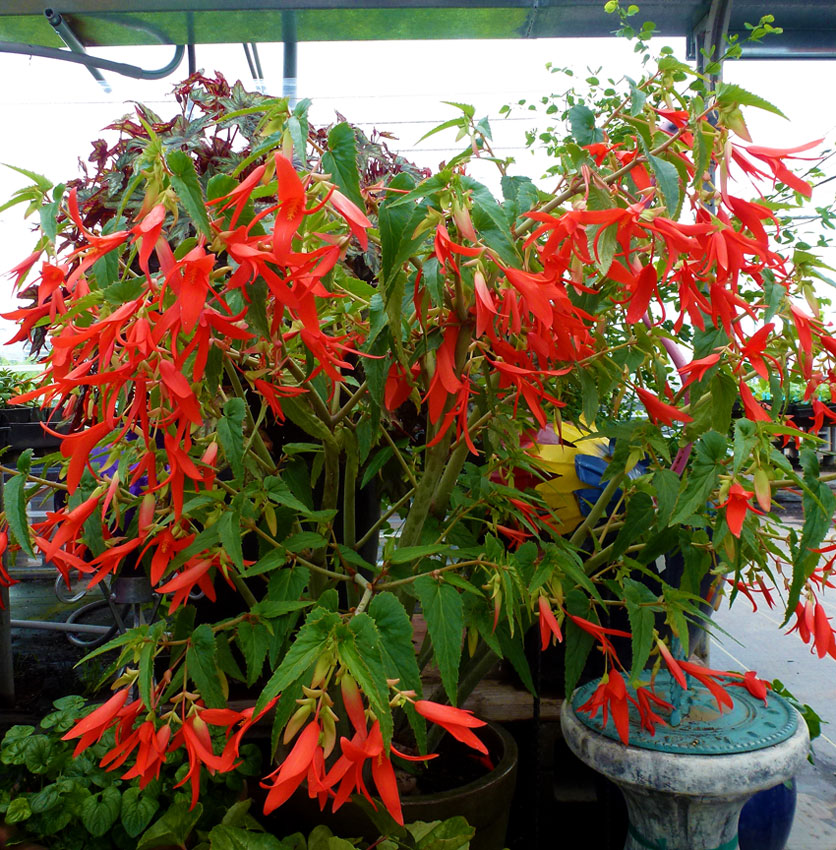
begonia boliviensis santa cruz
This variety is a showstopper with its fiery red flowers that bloom profusely from late spring to early fall. The ‘Santa Cruz’ is known for its vigorous growth and is perfect for adding a pop of colour to your garden or patio.
Begonia Boliviensis ‘Bonfire’
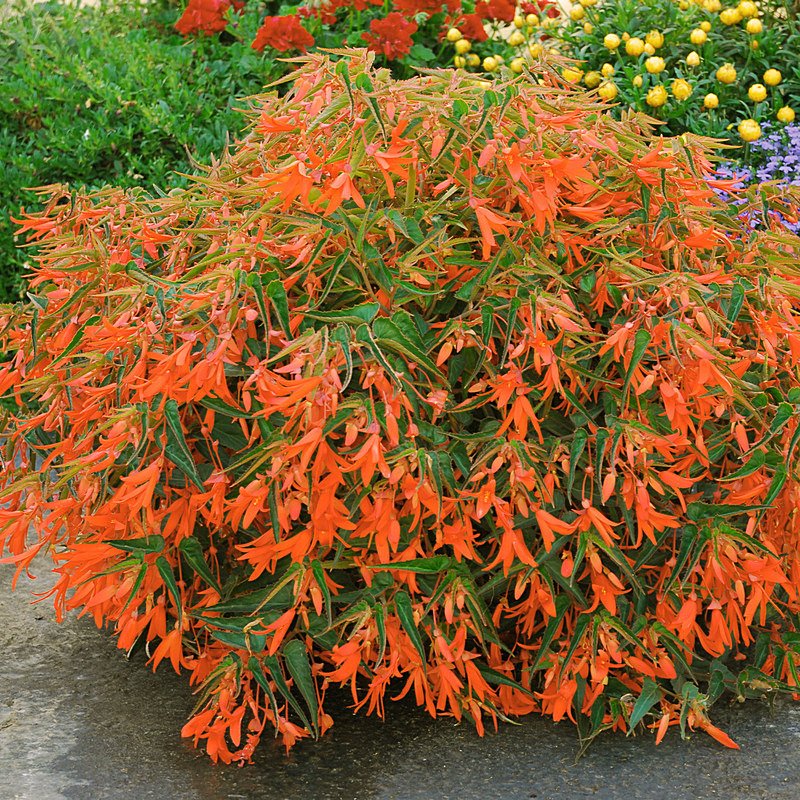
Begonia Boliviensis Bonfire
The ‘Bonfire’ variety is renowned for its striking orange blooms contrasting beautifully against its bronze foliage. This variety is prolific and will catch the eye in any garden setting.
Begonia Boliviensis ‘Bertini’
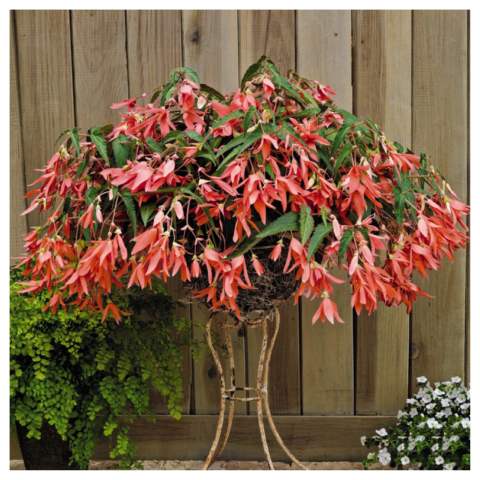
Begonia Boliviensis ‘Bertini’
This variety stands out with its bright yellow flowers. The ‘Bertini’ is a compact variety, making it an excellent choice for containers or small garden spaces.
Begonia Boliviensis ‘Bella’
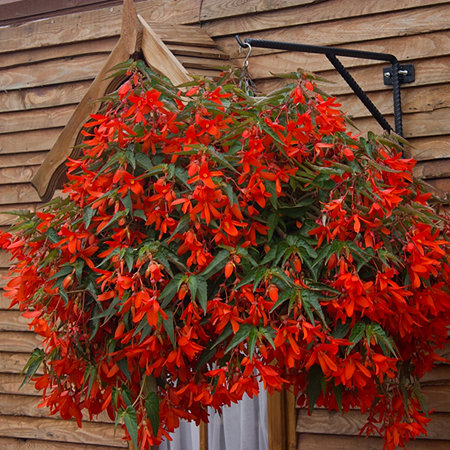
Begonia Boliviensis ‘Bella’
The ‘Bella’ variety is known for its delicate pink flowers that add a touch of softness to your garden. This variety is perfect for creating a serene and calming garden atmosphere.
Begonia Boliviensis ‘Waterfall Encanto Orange’
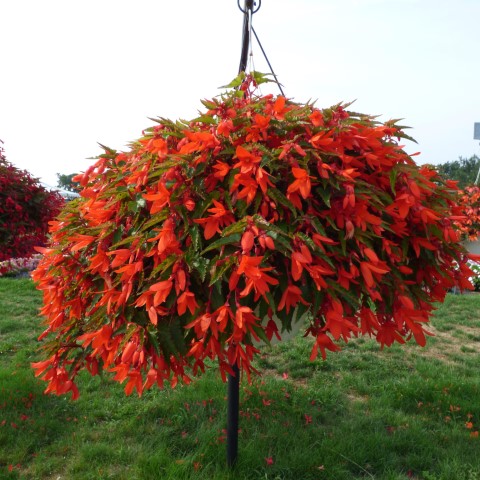
Begonia Boliviensis ‘Waterfall Encanto Orange’
This variety is a spectacle with cascading orange flowers that resemble a waterfall. It’s a great choice for hanging baskets or elevated planters.
Begonia Boliviensis ‘Million Kisses Elegance’

This variety is loved for its elegant salmon-pink flowers. The ‘Million Kisses Elegance’ is a robust variety with a semi-trailing habit, making it perfect for hanging baskets.
Growing Begonia Boliviensis: A Step-by-Step Guide
Growing Begonia Boliviensis can be a rewarding experience, especially when you see its vibrant flowers in full bloom. Here’s a step-by-step guide to help you grow this beautiful plant successfully:
Choosing the Right Location
Begonia Boliviensis thrives in semi-shady to sunny exposures. Bronze-leaved species prefer full sun. While it can grow in full shade, the plant may grow less and produce fewer flowers. Choose a location that meets these light requirements.
Preparing the Soil
The ideal soil for Begonia Boliviensis is well-drained and rich. A mix of heather substrate with 30% siliceous sand works well. Make sure the soil is loose and fertile before planting.
Planting
When planting Begonia Boliviensis, ensure the roots are well covered, but avoid burying the stem to prevent rot. The best time to plant is in early spring when the threat of frost has passed.
Watering
Watering should be done moderately, about twice a week in summer, if it’s very hot. Always wait for the soil to dry before watering again to avoid waterlogging.
Fertilizing: Fertilize once a month during summer with mineral fertilizer and add compost at the beginning of spring. This will give the plant the nutrients it needs to grow and bloom.
Winter Care
Begonia Boliviensis is not frost-tolerant. If you live in a region with harsh winters, consider growing the plant in a container that can be moved indoors during the colder months.
Patience
One interesting aspect of Begonia Boliviensis is its late emergence. The plant typically starts showing above-ground growth around mid-June. So, don’t worry if you don’t see any signs of life in early spring!
Caring for Begonia Boliviensis: Essential Tips and Tricks
Caring for Begonia Boliviensis involves a few key steps to ensure it grows healthy and blooms beautifully. Here are some essential tips and tricks for caring for your Begonia Boliviensis:
Watering
Watering is crucial for Begonia Boliviensis. Water the plant moderately, about twice a week in summer if it’s hot. However, always wait for the soil to dry before watering again to avoid waterlogging. Overwatering can lead to root rot, a common issue with Begonias.
Fertilizing
Begonia Boliviensis benefits from regular feeding. Fertilize once a month during summer with mineral fertilizer and add compost at the beginning of spring. This will give the plant the nutrients it needs to produce vibrant blooms.
Pruning
Regular pruning helps maintain the plant’s shape and encourages more blooms. Remove faded flowers to encourage more blooming and cut back any overgrown stems. This not only keeps the plant looking neat but also promotes healthier growth.
Monitoring for Pests and Diseases
While Begonia Boliviensis is quite resistant to pests and diseases, it’s important to watch for common issues like slugs and overwatering. Regularly inspect the leaves, stems, and soil for any disease or pest infestation signs.
Winter Care
If you live in a region with harsh winters, protecting your Begonia Boliviensis from the cold is important. Consider moving the plant indoors or sheltering during the colder months. Remember, this plant is not frost-tolerant.
Patience
- Remember that Begonia Boliviensis is a late-emerging plant.
- Don’t worry if you don’t see any signs of life in early spring.
- Be patient, and you’ll see growth around mid-June.
Troubleshooting Common Problems with Begonia Boliviensis: A Handy Guide
While Begonia Boliviensis is generally a hardy plant, it can sometimes encounter a few problems. Here’s a handy guide to help you identify and address these common issues:
Overwatering
One of the most common issues with Begonia Boliviensis is overwatering, which can lead to root rot. If the leaves of your plant start to yellow or wilt, you may be watering too much. Allow the soil to dry out between waterings to prevent this issue.
Underwatering
On the other end of the spectrum, underwatering can also be a problem. If your Begonia Boliviensis’ leaves are drooping or the plant looks generally unhealthy, it might need more water. Remember, this plant prefers a moderate watering schedule.
Poor Lighting
While Begonia Boliviensis can tolerate light conditions, it will bloom better in full shade. If your plant isn’t producing many flowers, consider moving it to a location with more light.
Frost Damage
Begonia Boliviensis is not frost-tolerant. If exposed to frost, the plant can suffer serious damage. If you live in a region with cold winters, consider growing your Begonia Boliviensis in a container that can be moved indoors during the colder months.
Pests
While generally resistant to pests, Begonia Boliviensis can sometimes be affected by slugs, especially when grown outdoors. Regularly inspect your plant and the surrounding area for signs of these pests. Consider using a natural pest control method to protect your plant if found.
Nutrient Deficiency
If your Begonia Boliviensis’ leaves are discoloured or their growth seems stunted, they might lack essential nutrients. Regular feeding with a balanced fertilizer can help address this issue.
Propagating Begonia Boliviensis: A Step-by-Step Guide
Propagating Begonia Boliviensis is a rewarding process allowing you to multiply and share your plants with others. Here’s a step-by-step guide to help you propagate your Begonia Boliviensis successfully:
Choose the Right Time
The best time to propagate Begonia Boliviensis is in early spring when the plant starts to show new growth. This gives the new plants a full growing season to establish themselves.
Select the Propagation Method
Begonia Boliviensis can be propagated through the division of the rhizome or by herbaceous cuttings. Both methods can be successful, but cuttings are often the easiest for beginners.
Prepare the Cuttings
If using the cutting method, select a healthy stem and cut it just below a node (where a leaf joins the stem). The cutting should be about 4-6 inches long and have at least one leaf.
Root the Cuttings
- Place the cuttings in a container with fresh, well-draining potting mix.
- Keep the soil moist but not waterlogged.
- Place the container in a warm, bright location without direct sunlight.
Wait for Root Development
The cuttings should develop roots after a few weeks. You can check for root development by gently tugging on the cuttings. If there’s resistance, roots have formed.
Transplant the New Plants
Once the cuttings have developed a robust root system, they can be transplanted into their permanent pots or outdoor location. Be sure to provide the new plants with the same care as mature Begonia Boliviensis.
Using Begonia Boliviensis in Garden Design: Creative Ideas
Begonia Boliviensis is a versatile plant that can be used in various ways in your garden design. Its vibrant flowers and trailing habit make it a standout addition to any garden. Here are some creative ideas for using Begonia Boliviensis in your garden design:
Hanging Baskets
Begonia Boliviensis is perfect for hanging baskets, thanks to its trailing habit. The cascading flowers create a stunning visual effect, especially when the plant is fully blooming.
Container Gardens
Begonia Boliviensis grows well in containers, making it a great choice for patios, balconies, or other small spaces. Pair it with other shade-loving plants for a beautiful container garden.
Garden Borders
Use Begonia Boliviensis to create vibrant borders in your garden. The bright flowers can help define different areas of your garden and add a pop of colour.
Vertical Gardens
With its trailing habit, Begonia Boliviensis is an excellent choice for vertical gardens. It can add depth and interest to a green wall or other vertical structure.
Mixed Flower Beds
Begonia Boliviensis can be mixed with other flowering plants to create a diverse flower bed. Choose plants with different bloom times to ensure colour throughout the growing season.
Window Boxes
Plant Begonia Boliviensis in window boxes for a beautiful display that can be enjoyed inside and outside the home. The trailing flowers will spill over the edge of the box, creating a stunning visual effect.
Conclusion
Growing Begonia Boliviensis is a rewarding experience, especially for beginner gardeners. Its vibrant flowers, resilient nature, and minimal care requirements make it an ideal plant to start your gardening journey. So why wait? Embark on your gardening adventure today with Begonia Boliviensis!
Frequently Asked Questions
How often should I water my Begonia Boliviensis?
Watering should be done moderately, about twice a week in summer if it’s very hot. However, always wait for the soil to dry before watering again to avoid waterlogging.
Can Begonia Boliviensis grow in full shade?
While Begonia Boliviensis can tolerate light conditions, it won’t bloom as well in full shade. For optimal flowering, choose a location with semi-shady to sunny exposures.
What type of soil is best for Begonia Boliviensis?
The ideal soil for Begonia Boliviensis is well-drained and rich. A mix of heather substrate with 30% siliceous sand works well.
How can I propagate Begonia Boliviensis?
Begonia Boliviensis can be propagated through the division of the rhizome or by herbaceous cuttings. The best time to propagate is in early spring, when the plant starts to show new growth.
What are some common problems with Begonia Boliviensis?
Common problems with Begonia Boliviensis include overwatering, poor lighting, frost damage, pests like slugs, and nutrient deficiency. Regularly inspect your plant and address any issues promptly to keep it healthy.
Can Begonia Boliviensis be grown indoors?
Yes, Begonia Boliviensis can be grown indoors. It makes a great houseplant and can be grown in containers or hanging baskets. Just ensure it gets enough light and isn’t overwatered.
When does Begonia Boliviensis start showing growth?
Begonia Boliviensis is a late-emerging plant. It typically starts showing above-ground growth around mid-June. So, don’t worry if you don’t see any signs of life in early spring.
What does Begonia smell like?
Most Begonias, including Begonia Boliviensis, do not have a strong scent. However, some varieties of Begonia do have a mild, pleasant fragrance. It’s best to check the specific variety for details.
Does Begonia maculata like humidity?
Yes, Begonia maculata, like many Begonias, prefers a humid environment. This makes it a great choice for bathrooms or kitchens where humidity tends to be higher.
How long does Begonia last?
With proper care, Begonia Boliviensis, a perennial, can live for many years. It typically blooms from late spring to early fall, providing vibrant colour for several months each year.
Is Dragon Wing Begonia a perennial?
Yes, Dragon Wing Begonia is a type of Begonia that is also perennial. It is known for its large, wing-shaped leaves and beautiful, drooping flowers.
Is Begonia Boliviensis a perennial?
Yes, Begonia Boliviensis is a perennial plant. This means it can live for more than two years, going through cycles of growth and dormancy.
Is Angel Wing Begonia toxic to dogs?
Yes, Angel Wing Begonia, like many Begonias, is considered toxic to dogs. If ingested, it can cause oral irritation, salivation, vomiting, and difficulty swallowing.
How to prune Begonia Boliviensis?
Prune Begonia Boliviensis removes faded flowers to encourage more blooming and removes any overgrown stems to maintain the plant’s shape.
How to overwinter Begonia Boliviensis?
To overwinter Begonia Boliviensis, move the plant indoors before the first frost. Please keep it in a bright, cool location and reduce watering. Gradually reintroduce the plant to outdoor conditions in spring before planting it out.
How to grow Begonia Boliviensis?
Grow Begonia Boliviensis in well-drained, rich soil with semi-shady to sunny exposures. Water moderately and fertilize regularly for optimal growth.
How to care for Begonia Boliviensis?
Care for Begonia Boliviensis involves regular watering (but avoiding waterlogging), fertilizing once a month during summer, and pruning to maintain the plant’s shape and encourage blooming.
How do you overwinter Begonia Boliviensis?
Overwinter Begonia Boliviensis by moving it indoors before the first frost. Please keep it in a bright, cool location and reduce watering. Gradually reintroduce the plant to outdoor conditions in spring before planting it out.
How to propagate Begonia Boliviensis?
Propagate Begonia Boliviensis through division of the rhizome or by herbaceous cuttings. The best time to propagate is in early spring, when the plant starts to show new growth.
How to root Angel Wing Begonias?
Root Angel Wing Begonias by taking a cutting just below a node, then placing it in a container with fresh, well-draining potting mix. Keep the soil moist and place the container in a warm, bright location.
How often to water Angel Wing Begonia?
Water Angel Wing Begonia when the top inch of soil feels dry to the touch. Overwatering can lead to root rot, so letting the soil dry out between waterings is important.
How much sun does a Rex Begonia need?
Rex Begonia prefers bright, indirect light. Too much direct sunlight can scorch the leaves, while too little light can cause the vibrant leaf colours to fade.
How tall do Dragon Wing Begonias grow?
Dragon Wing Begonias can grow up to 15-18 inches tall with a similar spread. They are known for their large, wing-shaped leaves and beautiful, drooping flowers.
